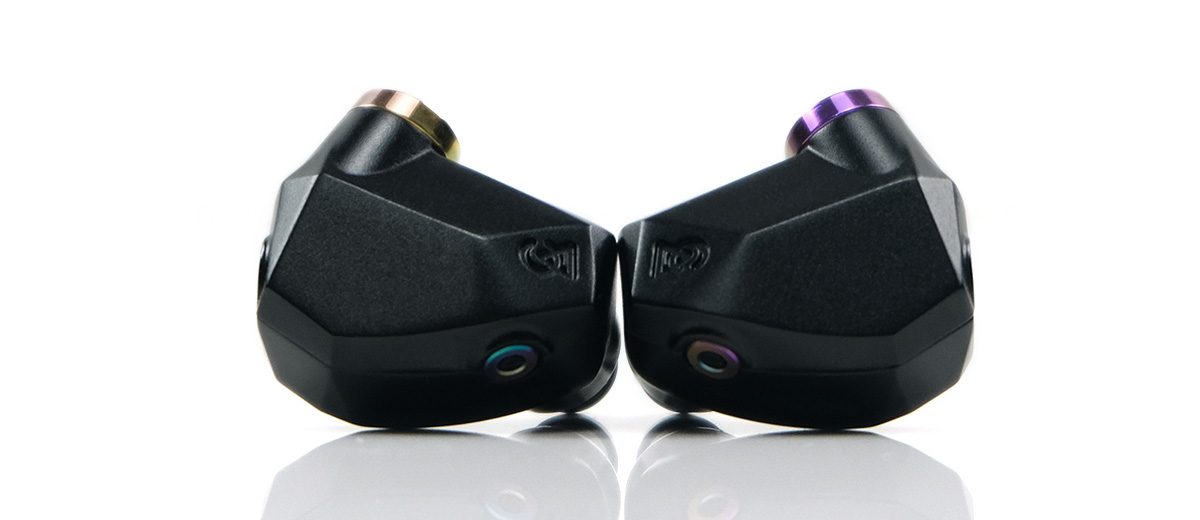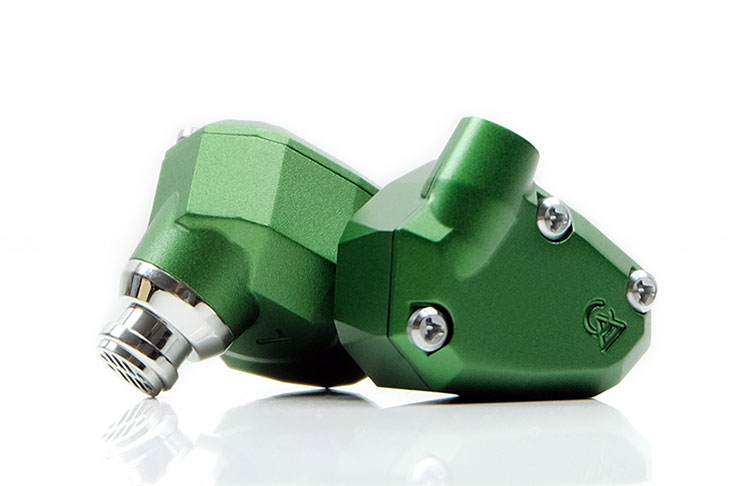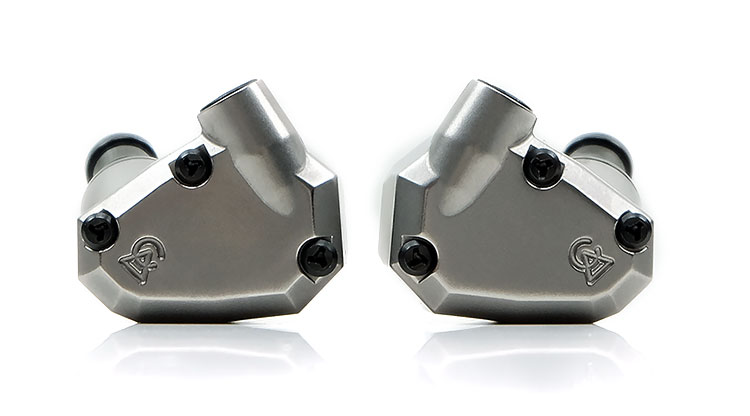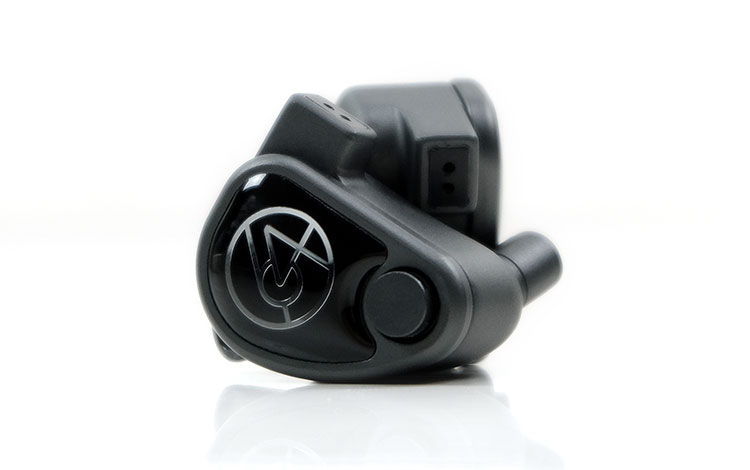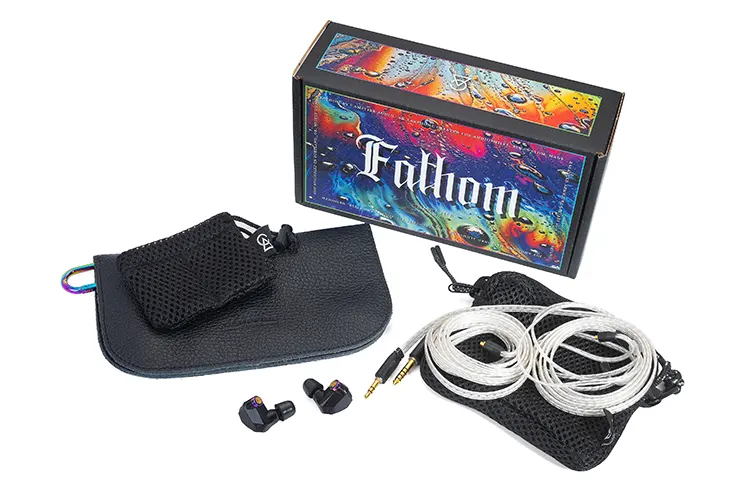Select Comparisons
The following selected comparisons to the Campfire Audio Fathom were completed with the R8 II DAP as the main source. Each IEM was using a Time Stream 4.4mm balanced cable combined with their respective stock tips.
Campfire Audio Andromeda 2020
The Campfire Audio Andromeda 2020 is the penultimate release in this legacy series which started back in 2016. We have yet to review the Emerald Series version. The Andromeda 2020 was, logically, released in the year of its title with our full review out that same year.
Technical
Like the Fathom, the Andromeda 2020 is also an all-BA monitor with a 5 instead of a 6-driver configuration.
Its precise configuration is dual tweeters in the highs using T.A.E.C, one balanced armature for the mids which is the same driver plucked from the Solaris SE, and one that I have always preferred tonally over the previous iteration, with a dual set of BA drivers for the lows.
The Fathom’s additional driver sits in the midrange with a dual configuration instead of a single BA. Fathom, however, is not listed as using T.A.E.C. which seems to be less of an ever-present in the company’s recent releases. Both IEMs use solid-body internal designs with an optimized 3D construction.
Both IEMs have almost matching impedance levels at 12.8Ω for the Andromeda 2020 and 11.7Ω for the Fathom with SPL not that far off either at 7.01 mVrms as opposed to the Fathom’s 6.75 mVrms rating.
You will find these two are very closely aligned in terms of being easily driven and fairly sensitive IEMs.
Design
The Andromeda 2020 is more ‘old-school’ Campfire Audio in terms of the form factor and the more nuanced aspects of its aesthetics.
To be honest, Fathom is very different from just about any aluminum-body Campfire IEM so it’s more the Fathom being the outlier than the Andromeda 2020.
I hope CA continues with the Fathom finishing and smaller form factor. It feels smoother in both the hand and the ear and also has a flusher fit. However, the lack of screws might also make it less easy to service compared to the older style.
In any event, the Andromeda is ‘edgier’ in its main shell finishing and slightly less comfortable as a result. I do not see much of a difference between the two size-wise from the Fathom’s stubbier MMCX connectors and longer spout though.
If anything, the Fathom might be perceived as slightly bigger because of the raised prism finish on the plates but that’s splitting hairs.
the level of passive isolation on both is about even though I do prefer to use silicon tips on the Fathom and foam on the Andromeda 2020. The slightly shorter nozzle on the 2020 model seems less able to isolate with the stock silicone tips whereas the Fathom spout is excellent with silicone for my ears.
The Fathom Time Stream cables are definite upgrades over the 1.32m 4-wire SPC Litz cable that comes with the Andromeda 2020. The only real benefit of the SPC Litz is that it’s lighter, thinner, and lower profile but can tangle quicker and has a higher level of resistance in its smaller gauge wire.
Performance
These are very close in their overall presentations and their general type of tuning. Both are very nicely balanced, now tub-thumping on the lows, overly cooked treble or instrumental, and vocal timbre with high levels of contrast.
Where the Fathom differs primarily in the bass and vocal presence as well as lower-treble amplitude. It offers a fuller and weightier performance on the lows, which in turn, gives it a bit more perceived depth and power and a better fundamental in note harmonics.
To compensate for that slightly lifted bass response the Fathom vocals are further forward sounding compared to the Andromeda 2020. The 1-2k region for both is lifted, but the Andromeda 2020 is more conservative with slightly less lower treble presence.
The Andromeda thus sounds more relaxed and slightly lighter in body for both instrument and vocal. I do think there is a slightly smoother tone from the Andromeda but a slightly less resolving level of texture through the mids.
You can tell the Fathom is using more drivers for the mids just by the richer fuller more detailed note quality over the same range.
The additional lift in the lower treble does help deliver a bit of harmonic balance also so whilst firmer on the lows it’s not in any way more rounded or duller sounding compared to the Andromeda 2020.
If anything, it’s the Fathom that has the more dynamic delivery across the board despite sharing a very similar overall tuning.
Campfire Audio Ara
The Campfire Audio Ara was launched in mid to late 2021 with our review of that same year. Arguably, the Fathom replaces the now discontinued Ara in the company’s line-up and for a lower price.
Technical
The Ara is also an all-BA driver design but this time with 7 as opposed to the Fathom’s 6. It has a driver configuration of 2 tweeters for the highs, one balanced armature for the mids, and four for the lows.
Note that like the Andromeda 2020, the Ara uses a single full-range driver for the mids similar to the custom version used inside the Solaris SE. It also uses T.A.E.C. which the Fathom has omitted but both have solid body technology internals with optimized 3D construction.
The Ara requires 7.094 mVrms to hit 94 dB SPL @ 1kHz which is marginally higher than the 6.75 mVrms benchmark for the Fathom so both would be classed as fairly sensitive IEMs. Neither IEM will give you any load issues at 8.5 Ohms @ 1kHz and 11.7Ω respectively unless you have a >2Ω output impedance source.
Design
Another classic design with a similar form factor to the Fathom but the major difference is this is the only CA IEM ever to use Titanium rather than their more widely used CNC’ed aluminum or resin bodies.
That does give it a denser and weightier feel in the hand, (and in the ear), compared to the aluminum body of the Fathom.
From the face-down, they look similar in size, but from the side, the Ara does look a little bit deeper in the shell with a stubbier shorter nozzle and an MMCX that is not quite as well integrated into the shell as the Fathom’s raised shell finish.
Like the Andromeda 2020, the Ara is edgier on its chamfered sharper cornering on the sides, which, combined with its stubbier nozzle makes it slightly less comfortable to wear compared to the much smoother cornering and shell shape of the Fathom.
These are BA IEMs so no venting on either shell meaning isolation is good and more or less on par with each other.
The passive isolation levels will vary with tips and back in the day, the Ara came with Final E tips which are excellent for isolation and penetration. I would rate them slightly for isolation better than the wide-bore tips that come with the Fathom.
The Ara uses the same 1.32m 4-wire SPC Litz cable with a smokey finished jacket as the Andromeda 2020. It’s not on the same level performance-wise as the 8-wire SPC Time Stream cables though a little lighter and lower profile if that is important to you.
Performance
To put it crudely the Fathom sounds a bit like the Ara but with bass. The low end is where these two monitors differ the most with the Fathom offering a comparatively voluptuous bass response, one that is warmer, firmer, and deeper sounding.
Of course, a strong warmer bass will affect however everything else sounds and with the tightly control bass performance from the Ara, there is less of a weighty fundamental and a stronger upper-harmonic influence beyond 500Hz.
That means the Ara has a more neutral and ethereal timbre through the mids and highs with a slightly leaner note weight, and more treble influence on the tuning giving it a more delicate airy quality to its presentation.
The Fathom is more aggressive on the lows, and though the imaging of the vocals between the two are similar, the enhanced weight and warmth give them a more robust and firmer sound.
The Ara does seem to present a bit more upper-treble sparkle but then again, the leaner bass weight can enhance that perception of more presence in the highs and mids coloration.
Overall, the Ara is going to draw your ear more to the mids and highs whereas I find the Fathom balances contextually more to the bass and mids with a smoother richer tuning.
64 Audio U6t
The 64 Audio U6t was also launched in 2021 and is still a popular staple in the company’s universal IEM lineup. Priced just a shade higher than the Fathom you can read our full review of the U6t here.
Technical
The U6t is also an all-BA 6 driver configuration with 2 for the lows, 2 for the mids, 1 mid-high, and a tubeless tia high driver for the highs.
Just a quick mention that 64 Audio along with CA and FiR Audio are 3 companies at the forefront of pushing tubeless driver technology over the last decade so it is a bit ironic that in this comparison the Fathom does not use T.A.E.C.
Another deviation is their respective crossover technology with the U6t using a more complex 4-way passive crossover and the Fathom a single high-point crossover.
64 Audio has also thrown several notable features that give it a more nuanced tuning approach, namely its apex tuning modules. These not only vary the level of bass attenuation output but in doing so change the entire performance.
Its primary function, however, is in the full name – Air Pressure Exchange. The concept is to reduce the level of pneumatic pressure on the eardrums thus affording them protection from long-term hearing damage.
On top of that the U6t comes with LID technology essentially rendering them impedance agnostic for potential low-z skew from high impedance outputs which may be less relevant in 2024 than it was 3-4 years ago.
The U6t uses the more traditional sensitive measurement system, rated at 10Ω and 108dB SPL. Like the Fathom it has a very low load level but it is less sensitive compared to the Fathom in our subjective testing with the balanced output of our test DAP, the HiBy R8 II.
Design
64 Audio has a very distinctive form factor that rarely deviates from its core shape even if the finishing and color schemes vary markedly. It’s a rigid teardrop shape with very smooth gradual curving and an elongated 2-pin terminated stem.
Compared to the Fathom, the U6t is bigger though, surprisingly so. I had thought they would be roughly the same size but side by side you can see the substantial size difference.
Both have that teardrop dimension but the U6t feels a bit more uniform and conservative in its lines whereas the more aggressive chamfering and prism-like raised plate give the Fathom a more distinct look.
They also are inherently dark-colored designs with the Fathom going with that rainbow PVD finish and uniform black bright-dip aesthetic. The U6t is more a mix of dark gunmetal for the body and an abbreviated piano black faceplate to allow some pace for the apex filters.
Because they are smaller, the Fathom will sit flusher to the ear compared to the U6t. Both are quite comfortable though. The U6t soft curves and relatively lightweight form factor barely touch the ear or press down uncomfortably.
Due to the apex tech, the U6t could be considered a vented BA design and indeed it does isolate a bit less compared to the Fathom with the apex modules with the lightest attenuation. The gap is closer with the m20 filter which attenuates the most but still not quite Fathom levels.
The U6t’s 4-wire 26AWG silver-plated OCC copper stock cable is good but not quite as open-sounding as the Fathom’s 8-wire Time Stream cable.
Performance
For this comparison, I opted for the M15 apex filter which is usually the default filter out of the box and the one I find to offer the most balanced performance.
In short, the U6t has a killer sub-bass performance and generally more forgiving tuning, while the Fathom has a more balanced and open-sounding presentation.
The key issue for me is the mids and highs where the U6t sounds comparatively veiled with a more rounded note quality. That comes from a very relaxed 5-10k region that sounds almost shelved down compared to the stronger treble energy from the Fathom.
That in turn gives the Fathom mids a better harmonic balance with some welcome contrast and energy through the 1-5k range which can sound a little too soft and smooth on the U6t.
The 64 Audio tuning has some lift from 1-5k but it’s south of ‘Harman neutral’ and not quite as well separated as the Fathom equivalent which places more emphasis on balancing out the stronger bass punch and weight.
The U6t cannot be beaten on sub-bass power and elevation in this comparison. It has a stronger fundamental and more depth compared to the Fathom which gives it a more rhythm-friendly profile. It’s the pick I would recommend for more consumer synth bass-heavy pop and rock recordings.
For anything that needs more mid-range ‘bloom’ and a better treble reach and presence for more complex vocal-centric recordings then the Fathom is my pick here.
Our Verdict
The Campfire Audio Fathom is a very balanced-sounding BA IEM with a natural, agreeable lilt to its sound signature combined with excellent vocal presence and impressive imaging.
Arguably, this is ‘next level’ Andromeda at ‘same level’ pricing. It also fills a high-end gap left by the since-departed Ara.
I would argue the Fathom is an improvement on both monitors with its superior bass weight and more agreeable timbre to both instrument and vocal. It has also improved in the looks department with superior stock cable choices which is a nice bonus.
Who should avoid it? Bassheads, anyone wanting explosive bass performances, or those looking for an endless treble extension. No dynamic or EST drivers here, CA has other tools for that job in their lineup that address a lot of that.
So, who will enjoy this? Well, this is a monitor aimed at audiophiles but honestly, it is an excellent choice for anyone who enjoys listening to music in all its complexity and detail but wants to avoid an IEM that’s overly sterile in achieving that.
Campfire Audio Fathom Technical Specifications
- Frequency Response: 5Hz – 20kHz
- Sensitivity: 94dB @1K = 6.75 mVrms
- Impedance: 11.7 Ohm @1K
- THD <1%

